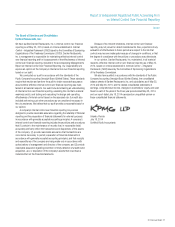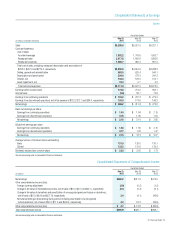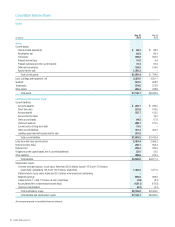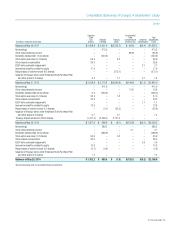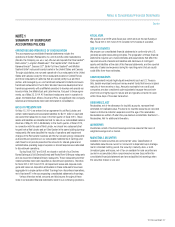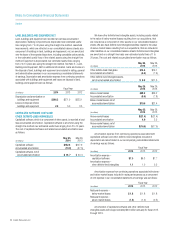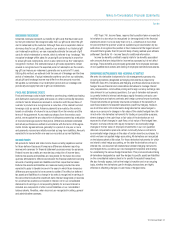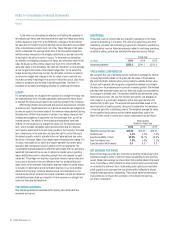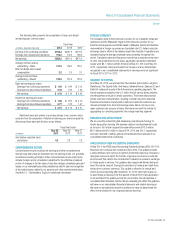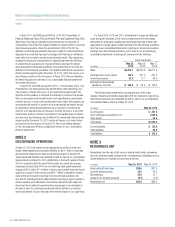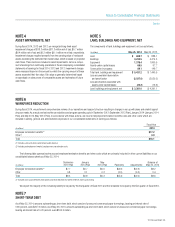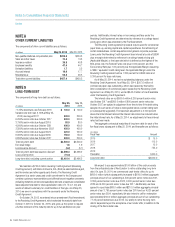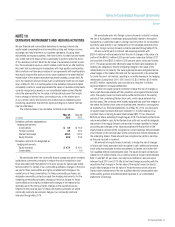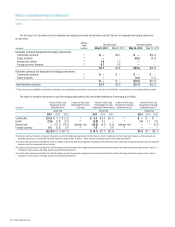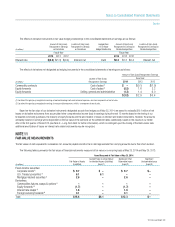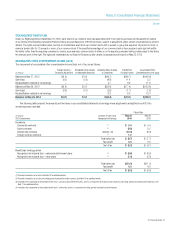Red Lobster 2014 Annual Report Download - page 33
Download and view the complete annual report
Please find page 33 of the 2014 Red Lobster annual report below. You can navigate through the pages in the report by either clicking on the pages listed below, or by using the keyword search tool below to find specific information within the annual report.
Notes to Consolidated Financial Statements
Darden
2014 Annual Report 31
UNEARNED REVENUES
Unearned revenues represent our liability for gift cards that have been sold
but not yet redeemed. We recognize sales from our gift cards when the gift
card is redeemed by the customer. Although there are no expiration dates or
dormancy fees for our gift cards, based on our analysis of our historical gift
card redemption patterns, we can reasonably estimate the amount of gift
cards for which redemption is remote, which is referred to as “breakage.” We
recognize breakage within sales for unused gift card amounts in proportion
to actual gift card redemptions, which is also referred to as the “redemption
recognition” method. The estimated value of gift cards expected to remain
unused is recognized over the expected period of redemption as the remain-
ing gift card values are redeemed, generally over a period of 10 years.
Utilizing this method, we estimate both the amount of breakage and the time
period of redemption. If actual redemption patterns vary from our estimates,
actual gift card breakage income may differ from the amounts recorded.
We update our estimates of our redemption period and our breakage rate
periodically and apply that rate to gift card redemptions.
FOOD AND BEVERAGE COSTS
Food and beverage costs include inventory, warehousing, related purchasing
and distribution costs and gains and losses on certain commodity derivative
contracts. Vendor allowances received in connection with the purchase of
a vendor’s products are recognized as a reduction of the related food and
beverage costs as earned. Advance payments are made by the vendors
based on estimates of volume to be purchased from the vendors and the
terms of the agreement. As we make purchases from the vendors each
period, we recognize the pro rata portion of allowances earned as a reduction
of food and beverage costs for that period. Differences between estimated
and actual purchases are settled in accordance with the terms of the agree-
ments. Vendor agreements are generally for a period of one year or more
and payments received are initially recorded as long-term liabilities. Amounts
expected to be earned within one year are recorded as current liabilities.
INCOME TAXES
We provide for federal and state income taxes currently payable as well as
for those deferred because of temporary differences between reporting
income and expenses for financial statement purposes versus tax purposes.
Federal income tax credits are recorded as a reduction of income taxes.
Deferred tax assets and liabilities are recognized for the future tax conse-
quences attributable to differences between the financial statement carrying
amounts of existing assets and liabilities and their respective tax bases.
Deferred tax assets and liabilities are measured using enacted tax rates
expected to apply to taxable income in the years in which those temporary
differences are expected to be recovered or settled. The effect on deferred
tax assets and liabilities of a change in tax rates is recognized in earnings in
the period that includes the enactment date. Interest recognized on reserves
for uncertain tax positions is included in interest, net in our consolidated
statements of earnings. A corresponding liability for accrued interest is
included as a component of other current liabilities on our consolidated
balance sheets. Penalties, when incurred, are recognized in selling, general
and administrative expenses.
ASC Topic 740, Income Taxes, requires that a position taken or expected
to be taken in a tax return be recognized (or derecognized) in the financial
statements when it is more likely than not (i.e., a likelihood of more than
50 percent) that the position would be sustained upon examination by tax
authorities. A recognized tax position is then measured at the largest amount
of benefit that is greater than 50 percent likely of being realized upon ultimate
settlement. See Note 16 – Income Taxes for additional information.
Income tax benefits credited to equity relate to tax benefits associated
with amounts that are deductible for income tax purposes but do not affect
earnings. These benefits are principally generated from employee exercises
of non-qualified stock options and vesting of employee restricted stock awards.
DERIVATIVE INSTRUMENTS AND HEDGING ACTIVITIES
We enter into derivative instruments for risk management purposes only,
including derivatives designated as hedging instruments as required by
FASB ASC Topic 815, Derivatives and Hedging, and those utilized as economic
hedges. We use financial and commodities derivatives to manage interest
rate, compensation, commodities pricing and foreign currency exchange rate
risks inherent in our business operations. Our use of derivative instruments
is currently limited to interest rate hedges; equity forwards contracts; com-
modities futures and options contracts and foreign currency forward contracts.
These instruments are generally structured as hedges of the variability of
cash flows related to forecasted transactions (cash flow hedges). However,
we do at times enter into instruments designated as fair value hedges to
reduce our exposure to changes in fair value of the related hedged item. We
do not enter into derivative instruments for trading or speculative purposes,
where changes in the cash flows or fair value of the derivative are not
expected to offset changes in cash flows or fair value of the hedged item.
However, we have entered into equity forwards to economically hedge
changes in the fair value of employee investments in our non-qualified
deferred compensation plan and certain commodity futures contracts to
economically hedge changes in the value of certain inventory purchases, for
which we have not applied hedge accounting. All derivatives are recognized
on the balance sheet at fair value. For those derivative instruments for which
we intend to elect hedge accounting, on the date the derivative contract is
entered into, we document all relationships between hedging instruments
and hedged items, as well as our risk-management objective and strategy
for undertaking the various hedge transactions. This process includes linking
all derivatives designated as cash flow hedges to specific assets and liabilities
on the consolidated balance sheet or to specific forecasted transactions.
We also formally assess, both at the hedge’s inception and on an ongoing
basis, whether the derivatives used in hedging transactions are highly
effective in offsetting changes in cash flows of hedged items.


